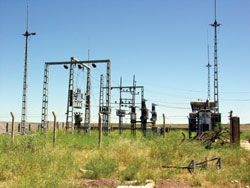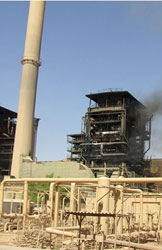POWER View: Bechtel's Dean Hagerty
Editor-in-Chief Dr. Robert Peltier recently discussed the state of Iraq's power system with Dean Hagerty, manager of Bechtel Corp.'s Power Iraq Infrastructure Reconstruction Project. From his office in Baghdad, Hagerty discussed the challenges of restoring power in a lawless country whose power infrastructure had been woefully neglected for decadesPeltier: Please describe for POWER's readers the condition of Iraq's electricity infrastructure when you arrived in the country.
Hagerty: What we found was a power system that sustained surprisingly little damage during the bombing and invasion. Coalition forces took pains to avoid hitting power plants and lines, and they were very successful at that. But for us, the downside of inheriting what appeared to be an essentially intact infrastructure was that people got the impression that restoring power would be easy. It was, and continues to be, anything but.
In Iraq, what's less visible is often more important. The country's power infrastructure was allowed to deteriorate over time as a result of a lack of money and attention from the government. Money that should have gone into infrastructure was instead used to build palaces. Every day, we see systems and pieces of equipment that were operated well beyond their normal technical parameters. Why were plants operated so irresponsibly? The answer is as horrible as it is simple: Operators faced arrest or worse if their plants came off-line, whatever the reason. To put it briefly, Iraq's power system—especially on the generation side—was just run into the ground.
Peltier: How long do you expect to be involved in the restoration of Iraq's power plants? And how do you measure how successful you've been?
|
"The country's power infrastructure was allowed to deteriorate over time as a result of a lack of money and attention from the government. Money that should have gone into infrastructure was instead used to build palaces." — Hagerty |
Hagerty: Bechtel has a contract from USAID [the U.S. Agency for International Development] that calls for a two-phase effort. Phase 1 ends on December 31 of this year, and Phase 2 ends at the end of December 2005. During both phases, our objective is increasing Iraq's usable installed capacity, both by rehabilitating existing plants and building new ones. As for how we measure success, the criteria are the same as those for any other project we undertake: Completion on time and within budget.
Peltier: Where do you recruit your plant operators?
Hagerty: Bechtel is not providing power plant operators. All plant equipment will be operated and maintained by Iraq nationals with technical assistance—including training—from us and others [see "Training computer-illiterate Iraqis to run gas turbines," page 64]. Training is par for the course on most jobs we do.
What we are providing are qualified engineers from our worldwide pool of personnel resources. They're in Iraq to do a good job, just as they do anywhere else. But I'd have to say that Iraq is perhaps the most difficult environment we've ever worked in, due to the security situation.
Peltier: How did the poor condition of Iraq's power plants factor into your plans to restore them to full capacity? According to General Strock, the Iraqis kept them going only through what he called their mastery of "sticks-and-strings engineering."
Hagerty: Couldn't have said it better myself. One of the first things we did when we hit the ground was to do a thorough assessment of every plant. In most cases, it revealed that we'd have our work cut out for us. Even an untrained observer would have come to the same conclusion.
Peltier: What about the transmission and distribution infrastructure?
Hagerty: Iraq's T&D system was and continues to be vulnerable to looting and sabotage. The good news is that incidences of both appear to have dropped off from last summer's level. Other organizations are involved in the repair of transmission lines and substations. Our work in this area currently is limited to one 400-kV line near Basra.
Peltier: How reliable is Iraq's electricity supply today? Are some areas getting more power than others?
Hagerty: At the national level, Iraq imports some power from Syria and Turkey. Under Saddam, the further you got from Baghdad, the more intermittent your service was likely to be. Before, it wasn't unusual for some areas to get power for two or three hours a day—if at all—while the capital was powered 24/7. Now, much of the country is on the same schedule, and what that has meant is less power for Baghdad, which has rolling blackouts like anywhere else. When you hear that reliability in Baghdad isn't the same as it was before the war, you need to keep that in mind.
Peltier: Is Bechtel working on both Iraqi power plants and those used by the occupation forces?
Hagerty: We work exclusively on—but again, do not
operate—the power plants and grid managed by the Ministry of Electricity. We
do no work for the military.
| Bechtel takes the point on restoring
power in Iraq |
||||||
|
The primary objective of Bechtel Corp.'s Power Iraq Infrastructure Reconstruction Project is to rebuild, repair, rehabilitate, and/or upgrade the country's power plants, restoring its total installed capacity to the pre-war level of 4,400 MW (see "Task Force 4400: Mission accomplished". A secondary objective is the institutional strengthening of Iraq's Ministry of Electricity. These are among the steps the company is taking to meet both objectives: • Procuring needed parts and other materials. |
In the field—in addition to supervising upgrading of the water treatment systems of some plants, providing technical expertise at others, and planning and building 440 MW of new capacity—Bechtel mostly has been working on rehabilitating two plants. They are the five-unit, 1,320-MW oil-fired Bayji Power Plant in Salahuddin Province (Figures 1 and 2) and Units 5 and 6 of the Doura Power Station in Baghdad (Figures 3 and 4). The Doura plant has four thermal units and four combustion turbines. Units 5 and 6 were built by Siemens (Kraftwerk Union) between 1978 and 1982; they are currently dismantled and awaiting new boilers. At Doura, Bechtel is refurbishing the turbines and replacing their control systems as well as replacing components of the plant's switchyard. The work is scheduled to be completed by this June. |
|||||
|
||||||
Copyright © 2004 - Platts, All Rights Reserved



